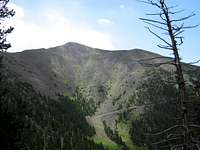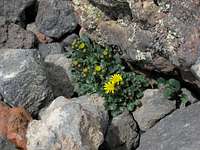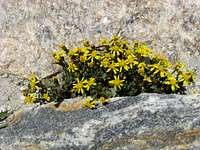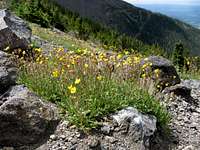lcarreau - Dec 12, 2010 11:00 am - Voted 10/10
Hello Mr. Leghorn..This report on the SFP Groundsel is long overdue.
Every so often, somebody writes in the forum:
"WHY can't I climb Agassiz when there's no snow on it ???"
I hope this report will answer their question.
Happy Holidays, man..
Alex Wood - Dec 13, 2010 8:12 pm - Voted 10/10
NiceI like the article and it is definitely needed. A few scientific inputs though..... A big reason the climate is so dry on the peaks is the fact that they are made out of basalt, which has little to no moisture retention. Basalt sucks up any moisture leaving no groundwater, which is partly due to its unweathered nature (the peaks are young geologically), but mostly due to the fact that that is just the nature of basalt.
For flora diversity- The big thing to take away here is that the alpine tundra is essentially an island. If change occurs, there is really no possible way for these plants to adjust to a different location due to the fact that the nearest alpine tundra aside from the peaks is well over 200 miles away. So because of this, the alpine flora is refined over and over again resulting in a unique varieties of species (evolution). Groundsel and bristlecone pines located on the peaks can be found elsewhere and are diverse, however changes that occurred as a result of isolation , especially above treeline, result in highly diversified flora species and in the case of the grounsel, the only know species. I know you brought up the fact that its the only place in AZ like it and how the environment effects these flora rarities, but isolation is the key reason the San Francisco Peaks have such rare alpine flora. The flora are on the edge of an environment and cannot go up or down because of this isolation from other like environments. This makes the alpine tundra extremely diversified.
Alex Wood - Dec 14, 2010 1:56 am - Voted 10/10
Re: NiceMost of it is basalt, with parts (like you said at the base) being dacite and then some of the more sheer outcrops are andesite. Basalt can definitely be found in most of the upper portions of the peaks. Either way, any of those rocks have super low moisture retention.
lcarreau - Dec 15, 2010 2:56 pm - Voted 10/10
Re: NiceSorry to interject, but that's an excellent point you made regarding the high winds.
Gotta agree that the "availability of water" remains a sensitive
issue. Just curious, but have you ever visited the "lava tube caves" to the SW of the Peaks. That explains how much of the
water actually finds its way into the ground.
P.S. - Personally, I have gained a much GREATER respect for the
"San Francisco Peaks volcano" after reading your article.
Outstanding job, Mister Leghorn! !
Alex Wood - Dec 22, 2010 2:22 am - Voted 10/10
Re: NiceTheoretically, the reason why stratovolcanos have andesite and rhyolite is because silica content in the magma changes as the volcano matures. I have always been told too that its andesite up there too. I was talking to one of my volcanologist professors at NAU and she was saying how she thinks there is a possibility of the majority of the rock type on the peaks to be a mix of basalt and andesite, which I think is true after cracking opening a dozen rocks along the rim, the crystal size and composition is similar to that of the same deposits on other nearby peaks. I have definitely seen all andesite intrusions high up on the peaks, but most of the rock along the rim is very black in color, which is more like basalt. There is still lots of discrepancy about the Peaks geologically speaking. Still think you have a good page!
gliderman - Dec 21, 2010 4:29 pm - Hasn't voted
Re: NiceA couple of side notes to all this.... If you get to the very top of Humphrey Peak, look carefully at the surface of the rocks. The southeast quadrant within about 30 feet of the tip top looks like it has prune juice spattered on it. These areas are actually geologic oddities called "fulgerites" which are created by the instant heat of lightning strikes that melt small portions of the rock. A friend an I mapped them for the Museum of Northern Arizona geology department back in the 60's. I'm not sure what meteorologic or geologic reasoning was behind 90% of the strikes to be in that particular area (90 degrees to 180 degrees on the compass), but for sure, it is NOT the place to hunker down if you happened to be there as a storm came along!
Another oddity of the Peaks... if you look at them from the south, such as from Flagstaff, there is an area that loses its snow cover first, appearing as sort of a bald spot in the snow. It is about 1/5 of the way down from the top and to the left of center when looking north. We always referred to it as the "hot spot", anthough that is just a relative term. A study of the area determined it was connected to deep fractures which allowed air from much lower down to be sucked up during atmospheric pressure changes. With a dry adiabatic rate of about 3 1/2 degrees / 1000 feet, this air coming up through the fractures was much warmer / far less cold than the ambient temperature at the surface of the mountain at that point, resulting in the snow cover melting / evaporating / subliming faster there than on much of the rest of the area above treeline that faces south. The area also gets some downforce winds (rotors) during some wind events, compounding the snow loss.












Comments
Post a Comment